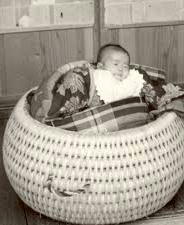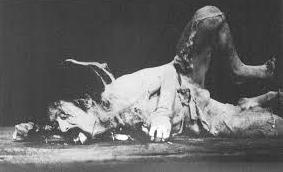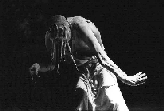Join our butoh workshops !
 We welcome those who are interested in deepening their physical and mental sensations through the training of Butoh dance method. Oh! Dance or Butoh experience is not required. We welcome those who are interested in deepening their physical and mental sensations through the training of Butoh dance method. Oh! Dance or Butoh experience is not required.
"Training of the body through Butoh dance method" involves perceiving various thoughts, emotions, and feelings that are evoked by posture and physical movements, and connecting the body and mind. For example, the commonly observed "ganimata" posture in traditional butoh performances becomes an experience that deepens the connection with the thoughts and emotions within that posture and movement.
In the old days, in the rural villages of Tohoku, there existed a woven straw basket-like cradle (for a new born baby) called "izumeh" (the literal meaning is "rice-stuffing") which was used to keep nursing infants from escaping while their parents toiled in distant rice fields, sweating profusely in the hot and stuffy summer.

Regardless of whether their baby cried or screamed towards the open sky, their voices would never reach anyone. Then, as Tatsumi Hijikata once recounted, in the evening when the parents returned, they would extract the infant from the izumeh, and the baby, with bent and numbed legs, had to find their own legs before moving again, not even knowing where their legs were. Therefore, "ganimata" (a wide-legged posture) was not merely about the physical position of the legs; it was intertwined with feelings of "helplessness, anger, resentment, sadness," or even "curses."
 Being present with the "unique movements" and the accompanying thoughts and emotions that are deeply ingrained in one's body and mind... That becomes the foundation of "physical training through Butoh dance method."
Being present with the "unique movements" and the accompanying thoughts and emotions that are deeply ingrained in one's body and mind... That becomes the foundation of "physical training through Butoh dance method." 
The various individual distortions and scars of one's fingers, hands, elbows, arms, shoulders, back, abdomen, waist, knees, legs, ankles, and soles of the feet... They serve as evidence of "my existence." And by experiencing and embracing them, one begins the journey of authentic Butoh dance. Thus, Butoh dance is not merely a form of dance but becomes a gateway to something else, maybe towards the heaven and/or the hell and/or ...
*During the tea break, videos of Tatsumi Hijikata, Kazuo Ohno, Dairakudakan, Sankaijuku, Yukio Waguri, Hoppo Butoh-ha, GooSayTen, and others will be shown.
(added. June,2023)
|
Butoh techniques
I have avoided using the term "butoh techniques" for years. The reason was very simple: there have been confusions and misunderstandings about the term "technique" of butoh, especially among the new comers of butoh dance.
Beginners, in general, tend to think that there are certain ways by which they can accomplish their goals soon. Well, it is not that easy in any given field, and the reason is again very simple also in butoh dance. You are not the average person with the average height, the average weight, and the average body construct in terms of muscles, tendons, bones, visceras, hormone secretion, etc.
It seems easy to walk, but it was not easy at all for toddlers. They have to find out their own ways to stand up and step forward based on their own characteristic physicality of the body.
Then, the term "technique" mainly means the techniques of the person's ability to move their body effectively, and in dance in general, the term "tehchnique" is something trained or built in his/her body including the capacities of each sensing ability such as vision, hearing, somesthesis/somesthesia or bodily sensation, and etc.
If you are blessed and privileged fully enough in these bodily functions, you will be succesful in any dance or any sports area. However, we are generally not so much blessed, to our regret, and here appears a fundamental issue for us to do something by using our awkward bodies. I believe that this was the very starting point of butoh when Hijikata struggled to get out of the western ideas of "mondern dance".
* I found that most beginners did not know the fact that one of Hijikatata's leg was a bit shorter than the other because of the injury he got in his high school days. Akiko Motofuji, his wife and cofounder of Butoh, told us that she needed to do some sewing with the Hijikata's trousers to adjust.
These days, many butoh dance people tend to start their training and performance not in Japan. However, Butoh dance have many cultural backgrounds of Japan about how to use the body, or to walk, to run (* Ninjas don't run as you do), to look at (* roll-back eyes, peripheral vison), etc.. For example, "Ganimata" (bandy legged), "geta ashi" (a kind of flex position as if putting a wooden sandal on), are some of the leg/foot positions in butoh dance, and have long cultural histories based on the body characteristics of Japanese people (or maybe of South East Asian people, but I would like to avoid generalization).
These body positions and the necessary bodily maneuvers are new to ,say, many European and Western people, and all you have to do is to assimilate oneself into a kind of bizarre way for the body use.
However, a well trained butoh dancer outside of Japan seems to overcome those Japanese butoh techniques gradually after realizing that their bodily dimensions are sometimes too different from those of the average Japanese people...
We have been teaching those basic body positions or techniques of butoh dance in Japan, but we understand that those are a kind of start line of "YOUR OWN BUTOH", although we hope the trajectory of your butoh is, to some extent, based on or influenced by the Japanese butoh originated by Tatsumi Hijikata, Kazuo Ohno, and other great butoh figures.
We have developed our own butoh approach by utilizing, say, Noguchi Taiso (physical exercise), and etc. for more than 30 years. The following examples might sound absurd, but they are often used in butoh lessons. There are many hints and suggestions in those techniques and training methods for you to develop your body-mind ability and deepen your butoh dance world more.
*I have been studying the body-mind psychology in terms of butoh dance since 1980s.
- Ganimata (bandy legged).
- Geta ashi (a flex position in butoh)
- Datsu ryoku (tension release and falling)
- Ne-nyoro (snaky movement in the lying position, in Noguchi Taiso)
- Jaw muscle exercise.
- joint locking and twisting techniques.
- intensional movements versus unconscious movements.
- exhaling exercise in your body movements for nuance.
- "Kann noh meh" (passive eye of Kann or peripheral vision)
- others...
Please learn more some of Japanese butoh dance basics, and then develop them for your next step as a performer or for bodymind integration
together with us in our butoh workshop in Sapporo, Japan.
Itto Morita (revised in May 2019)
|
Some explanations concerning Butoh:
You can find the following topics below:
|
* The following articles were first written in 2016.
Is butoh a contemporary dance ?
Butoh has proliferated around the world since 1980s when the eminent Japanese butoh dancers and groups started performing in Europe and U.S.A., and butoh was gradually thought to be one of contemporary dance styles especially after the end of 20th century when many non Japanese dancers started claiming that butoh is his/her own contemporary dance style.
It is O.K., but we believe that butoh has kept so-called archaic factors in it since its birth in Japan in 1950s. It is very clear when you read Hijikata's articles about butoh: there are numerous non-ordinary perceptions and feelings described well with no relationship with contemporary dance. (His major books and writings have not been fully translated to other languages yet.)
Most of his writings sounds like poetry, but they are not poems but a kind of amalgamation of bodily perception and imagination (my interpretations as a Japanese butoh-ist). One of Hijikata's writings, "Jealousy about dog's veins" sounds crazy, but it accurately describes what Hijikata felt and associated his feelings about his thin body as a walking skeleton. The dog's veins stand out in strong relief, and they seem to symbolize starvation and essential greed as a struggling creature ...
It is not very much contemporary, rather much more real, essential, and genuine.
Butoh as body-mind archaelogy.
I have used a word "body-mind archaelogy" since we discover very primitive or archaic responses in our body in butoh training. They might look like intentional body distortions, seen in traditional butoh performances sometimes, but they are not. Most of them are examples of Autogenic release, recovering the original body-mind homeostasis that was broken under the pressure of personal incidents or social/cultural strains.
We are interested in exploring and restoring these authentic factors in our body-mind through butoh training. Total relaxation may give rise to natural jerky/convulsive movements or vibrations. They are examples of Autogenic release, through which we often explore ourselves and liberate our body-mind. We believe this is one of the entrances toward authentic butoh.
Practice in the peaceful and relaxing atomosphere.
 We, Itto and Mika, have been performing together since 1995 as Butoh GooSayTen, and both are certified dancetherapists of Japan Dance Therapy Association, having presentations in academic conferences in U.S.A. and Europe. We, Itto and Mika, have been performing together since 1995 as Butoh GooSayTen, and both are certified dancetherapists of Japan Dance Therapy Association, having presentations in academic conferences in U.S.A. and Europe.
But, our training is physically oriented one with a series of physical exercises. We tend to avoid a visual imagery or over-conceptulization, and , rather, try to keep ourselves open to what is occurring in our own body-mind based on the enhanced body-mind sensibilities.
Anyway, you will be able to practice butoh in the peaceful and relaxing atomosphere, and then we proceed towards intensive practices together.
We would be happy to have you in Mika's cozy studio for intensive butoh workshops in Sapporo.
Butoh GooSayTen : Itto and Mika
(C) All rights reserved by Itto Morita, 2026
|




